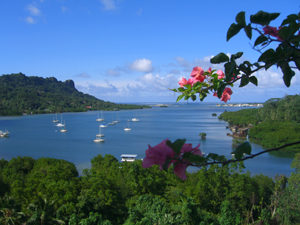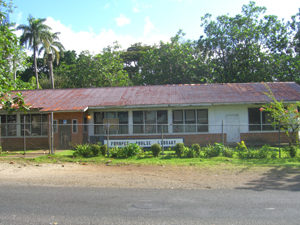


I left Kwajalein for Pohnepi on December 26th, 2009 about 1pm. Uneventful flight, we made a brief stop in Kosrae. I had wanted to get some green tangerines but none were available. Great weather when I arrived in the state capital city of Kolonia, the largest city. My bags were the first off, brought to the baggage area by a forklift though. I hauled my bags over to the customs officer who waved me through without looking at them. Apparently, I didn't look like a smuggler. Usually, it is women that think I am harmless. The immigration official took my passport and stamped it. He gave me an entry permit although Americans are supposed to enjoy unlimited visitation to Pohnpei as is the Pompeian right to visit the US with nearly the rights of citizens under the Free Association Agreement. Anyway, it was under five minutes to get my bags and get outside of the airport. A car was waiting to take me to the Ocean View Hotel. My driver was a young (twenty something) woman, Lois.  Over the next nine days I would get to talk to Lois quite a bit which was a very nice part of my visit. The hotel is divided into an east and west section--some problem with inheritance, I think. There are about eight rooms on the ocean side and eight on the street side. My room was especially nice. When I arrived the door was open and there was a small balcony overlooking Sokehs bay and Sokehs rock. Air was flowing through the room, but it was warmer and more humid than I cared for so I tried to figure out the air conditioner. It wasn't working so I called downstairs. The remote was missing. Remote? Well I guess everything has a remote anymore. It was a bit cryptic until I found where the instructions were hidden. The hotel being concerned about pleasing me had the entire AC unit replaced the next day.
Over the next nine days I would get to talk to Lois quite a bit which was a very nice part of my visit. The hotel is divided into an east and west section--some problem with inheritance, I think. There are about eight rooms on the ocean side and eight on the street side. My room was especially nice. When I arrived the door was open and there was a small balcony overlooking Sokehs bay and Sokehs rock. Air was flowing through the room, but it was warmer and more humid than I cared for so I tried to figure out the air conditioner. It wasn't working so I called downstairs. The remote was missing. Remote? Well I guess everything has a remote anymore. It was a bit cryptic until I found where the instructions were hidden. The hotel being concerned about pleasing me had the entire AC unit replaced the next day.
Since it was about 2:30 in the afternoon when I arrived, I decided to go for a walk. It was only about two miles, which is about the limit for my knee at the moment. I saw lots cars and people out and about. I had been concerned as Pohnpei is the second rainest place on the planet. They get over 200 inches a year in Kolonia and more in the mountains. Kwaj gets 100 inches per year. Kwaj has a rainy and dry season. Pohnepi does not. This is certainly a poor thrid world country, but unlike most of the Marshall Islands there is plenty of food in the jungle. No one goes hungry here. Sadly they are moving to the American diet. You can almost tell a woman's age by how wide she is. Men for the most part are skinny. Homes here, no matter how tiny, or how poor the family is will have a flower garden. I walked through many a tiny village and saw women sweeping the street in front of their homes to keep it clean. They do have minor litter problems, some environmental issues to deal with, but the people are friendly and hopeful.
 The library had me worried initially. It was closed on Saturday (Sunday too) and protected by a security fence. Apparently it has 85,000 volumes that are all donated. The library is on the grounds of the botanical gardens. I did not get to visit the gardens but others have told me that I should do so on my next visit.
The library had me worried initially. It was closed on Saturday (Sunday too) and protected by a security fence. Apparently it has 85,000 volumes that are all donated. The library is on the grounds of the botanical gardens. I did not get to visit the gardens but others have told me that I should do so on my next visit.
I wandered back to the hotel about 5 pm. The power was off so I went to the restaurant which is openaire. I asked how long the power would be off. They shrugged like it was a common thing. It came on shortly but I just sat there with my Diet Coke and book (The Lonely Life by Bette Davis). The staff would come by and talk from time to time but didn't try to get me out of restaurant. I did meet Jack a 50 something man from Illinois and his twenty something Pohnpeian wife. They seemed happy. He told me that they return to the island four times a year so she can be with her family. They weren't staying at the hotel so I didn't see them again. I ordered the Pohnpei Pepper Steak. Tasty but a bit tough. The Oceanview is definitely a two star hotel by American standards, but it is clean and the staff very friendly and the rates very, very reasonable. I would stay there again.

Pohnpei (Ponape until 1984), Kosrae (Kosaie until 1990), Chuuk (pronounced chooke, and Truk) and Yap are the four major islands in Federated States of Micronesia. (Palau opted out of being part of FSM in 1979.) FSM is a sovereign sate in free association with the United States and were formely part of the Trust Territory of the Pacific Islands. This was a UN project just after World War II where most ot the islands in the South Pacific were divided up into protectorates by New Zealand, Australia and the US. In 1979, they adopted a constitution and became independent in 1986 (November 23rd if I remember correctly). The major industry is government which is subsidised by the US under the compact, which ends in 2024 (more on that later).
The Federated States of Micronesia is spread across the Caroline Islands in the wider region of Micronesia, which consists of hundreds of small islands divided between several countries. The term Micronesia may refer to the Federated States or to the region as a whole. In some texts, micronesia (which means small islands) refers to much of the South Pacific. The total number of islands in FSM is 607. The four major states are represented by a star on the national flag.
Economic activity in FSM consists primarily of subsistence farming and fishing. The islands have few mineral deposits worth exploiting, except for high-grade phosphate. The potential for a tourist industry exists, but the remoteness of the location and a lack of adequate facilities hinder development. There are many impediments to development. First, there is plenty of fruit in the jungle and many of the 34,000 population lives in the remote parts of the island (roughly circular and about 300 sq miles). All land is owned by a Pohnpeian and cannot be sold to foreigners. Apparently hard to sell period. I saw no for sale signs on anything while I was there. Geographical isolation and a poorly developed infrastructure are major impediments to long-term growth. Tourism used to amount to about 10,000 people per year, now down to 4,000. The travel constraints imposed after 911 and poor economy contribute to the decline also. Pohnepi is worth making the effort to see.
The culture here is all about family. There is a significant influence by a number of churches. Sundays see most business closed and Holidays are worse. However, I saw no children or adults begging or in ragged clothing. When the missionaries arrived in numbers they encouraged the women to cover up their breast (I was disappointed but I hear they have not influenced many on Yap, yet). Many of the women, especially the older can be seen wearing two skirts, one above the other. Must have been an easy solution to appease the missionaries. I did see many small children playing naked, but that was true in the US when I was a wee lad, more of a statement about comfort than poverty.